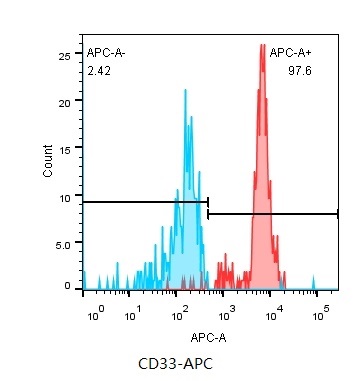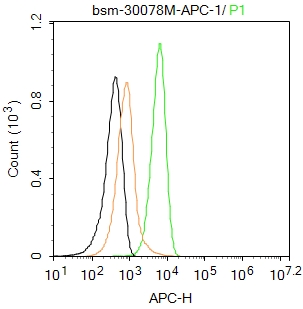
Mouse Anti-human CD33-APC antibody
CD33_HUMAN; CD 33; CD33 antigen; CD33 molecule; FLJ00391; gp67 ; Myeloid cell surface antigen CD33; Myeloid cell surface antigen CD33 precursor; p67 ; Sialic acid binding Ig like lectin 3; Sialic acid binding immunoglobulin like lectin 3; SIGLEC3; Siglec-
View History [Clear]
Details
Product Name human CD33-APC Chinese Name APC标记人CD33单克隆抗体 Alias CD33_HUMAN; CD 33; CD33 antigen; CD33 molecule; FLJ00391; gp67 ; Myeloid cell surface antigen CD33; Myeloid cell surface antigen CD33 precursor; p67 ; Sialic acid binding Ig like lectin 3; Sialic acid binding immunoglobulin like lectin 3; SIGLEC3; Siglec-3; myeloid cell surface antigen CD33 isoform 1 precursor. APC anti-human CD33; Research Area immunology Stem cells Cell Surface Molecule Immunogen Species Mouse Clonality Monoclonal Clone NO. HI33a React Species Human, Applications Flow-Cyt=5ul/Test
not yet tested in other applications.
optimal dilutions/concentrations should be determined by the end user.Theoretical molecular weight 40/37kDa Cellular localization The cell membrane Form Liquid Lsotype IgG2a Purification affinity purified by Protein G Buffer Solution 0.01M PBS, 0.5%BSA, 0.03%Proclin300 Storage Store at 2-8℃ for one year. Avoid repeated freeze/thaw cycles. Attention This product as supplied is intended for research use only, not for use in human, therapeutic or diagnostic applications. PubMed PubMed Product Detail CD33 is found on granulocyte and macrophage precursors in the bone marrow, but is not on pluripotent stem cells. The protein is also expressed on, and is a useful marker for, peripheral monocytes. It is also useful for distinguishing myelogenous leukaemia cells from lymphoid or erythroid leukaemias.
Function:
Putative adhesion molecule of myelomonocytic-derived cells that mediates sialic-acid dependent binding to cells. Preferentially binds to alpha-2,6-linked sialic acid. The sialic acid recognition site may be masked by cis interactions with sialic acids on the same cell surface. In the immune response, may act as an inhibitory receptor upon ligand induced tyrosine phosphorylation by recruiting cytoplasmic phosphatase(s) via their SH2 domain(s) that block signal transduction through dephosphorylation of signaling molecules. Induces apoptosis in acute myeloid leukemia (in vitro).
Subunit:
Interacts with PTPN6/SHP-1 and PTPN11/SHP-2 upon phosphorylation.
Subcellular Location:
Cell membrane; Single-pass type I membrane protein.
Tissue Specificity:
Monocytic/myeloid lineage cells.
Post-translational modifications:
Phosphorylation of Tyr-340 is involved in binding to PTPN6 and PTPN11.
Phosphorylation of Tyr-358 is involved in binding to PTPN6.
Similarity:
Belongs to the immunoglobulin superfamily. SIGLEC (sialic acid binding Ig-like lectin) family.
Contains 1 Ig-like C2-type (immunoglobulin-like) domain.
Contains 1 Ig-like V-type (immunoglobulin-like) domain.
SWISS:
P20138
Gene ID:
945
Database links:Entrez Gene: 945 Human
Omim: 159590 Human
SwissProt: P20138 Human
Unigene: 83731 Human
Product Picture
Primary Antibody (green line): Rabbit Anti-CD33 antibody (SLM-30078M-APC)
Dilution: 1ug/Test;
Protocol
The cells were incubated in 5%BSA to block non-specific protein-protein interactions for 30 min at room temperature .Cells stained with Primary Antibody for 30 min at room temperature.Acquisition of 20,000 events was performed.
References (0)
No References
Bought notes(bought amounts latest0)
No one bought this product
User Comment(Total0User Comment Num)
- No comment




 +86 571 56623320
+86 571 56623320
 +86 18668110335
+86 18668110335

